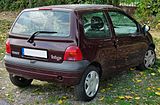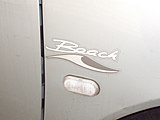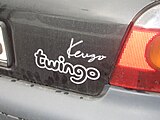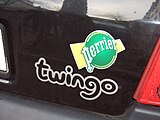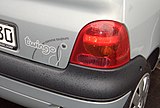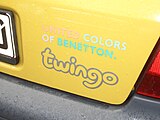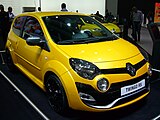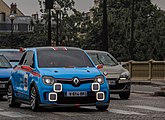Renault Twingo
| Renault Twingo | |
|---|---|
| Production period: | Since 1993 |
| Class : | Microcar |
| Body versions : | Station wagon |
The Renault Twingo is a four-seater microcar made by the French manufacturer Renault . It was introduced in the spring of 1993 and, with several million units to date, is one of the best-selling mass - production models among passenger cars . In Germany alone, over half a million first generation Twingo were sold.
Development history
One of the main inspirations for the design of the Renault Twingo was the prototype Beskid 106 from the Polish manufacturer FSM , about ten years older , which was supposed to replace the small car 126p manufactured by FSM at the time under a Fiat license . The Beskid 106, designed by the Polish designer Krzysztof Meissner , had a mono-box room concept that was new at the time and had been aerodynamically optimized. FSM or its design company BOSMAL had the Beskid design protected, but since the car did not go into production and the patents could not be extended for financial reasons, Renault took over the concept.
In October 1992, Renault presented the Twingo designed by Patrick le Quément at the Paris Motor Show in Paris , which, with its unusual design and interior concept, was offered for almost 15 years without any significant changes.
The name Twingo is a fantasy word from the copywriter Manfred Gotta . The name should sound cheerful and original. Renault wants to combine two ( English twin ) vehicle types (small car & minivan) in the Twingo .
During its 14-year construction period in France, the first Twingo in Germany found more than 500,000 buyers. It was produced until June 28, 2007 in the Flins-sur-Seine plant ( France ); During this time, 2,478,648 units were built. After that, production continued in Colombia for the South American market until June 8, 2012. In total, over 2.6 million units of the first generation of Twingo rolled off the assembly line.
Twingo I (1993-2012)
| 1st generation | |
|---|---|
|
Renault Twingo (1993-1998) |
|
| Production period: | 1993-2012 |
| Body versions : | Station wagon |
| Engines: |
Otto engines : 1.2–1.3 liters (40–55 kW) |
| Length: | 3433 mm |
| Width: | 1630 mm |
| Height: | 1423 mm |
| Wheelbase : | 2347 mm |
| Empty weight : | 890 kg |
| Stars in the Euro NCAP - Crash Test (2003) |
|
The first generation was introduced in March 1993 with an initially 40 kW (54 PS) 1.3-l OHV engine with timing chain, which had been used in the Renault 5 and various other Renaults since 1972 (C-engine). A folding roof was available as an optional extra from October 1993 at an additional cost of DM 800 .
In September 1994 the driver airbag became standard in the Twingo, followed a month later by the Twingo "Easy" with an automatic clutch system (advertising slogan at the time: "Shifting without clutch ").
In September 1995 the front passenger airbag became standard, and ABS was available at an additional cost.
The D7F engine with a displacement of 1.2 liters was installed in the Twingo from May 1996. Initially, it also produced 40 kW (54 PS) before its output was increased to 43 kW (58 PS) in August 1997 and to 44 kW (60 PS) in January 2001.
Interior concept
The interior of the vehicle can be flexibly redesigned in just a few simple steps. The rear seat can be moved in its position in three stages and can be folded completely forwards as well as folded backwards. The two front seats can be moved on a rail in the direction of travel and the seat angle can be adjusted. If you remove the headrests, you can fold the backrest completely back and get a two-meter-long lying surface flush with the rear bench, which is also folded back.
Facelift
The vehicle received a comprehensive model upgrade for phase II in the summer of 1998 (painted and modified front and rear bumpers, new dashboard in the interior and technical changes). Newly introduced in 1999 was a version called “Initiale” with leather seats, air conditioning and an optional navigation system . At the end of 2000 it was extensively modernized under the sheet metal cover (including safety technology, brakes, motor) for phase III.
In autumn 2004 the Twingo received another slight facelift (phase IV) , recognizable by the Renault rhombus on the tailgate.
In August 2004 the D7F engine with 8 valves was replaced by the D4F 708 with 16 valves. The performance of the entry-level engine remained unchanged at 44 kW (60 hp).
The Twingo I was economically successful and popular as a second car. The contemporary design, the interior concept and the folding roof , which is available at an additional cost, contributed to this.
Technical specifications
| Twingo | Twingo 1.2 | Twingo 1.2 16V | |||
|---|---|---|---|---|---|
| Construction period | 03 / 1993-10 / 1996 | 05 / 1996-12 / 2000 | 01 / 2001-06 / 2007 | 08 / 2004-06 / 2007 | 01 / 2001-06 / 2007 |
| Engine characteristics | |||||
| Engine type | R4 petrol engine | ||||
| Number of valves per cylinder | 2 | 4th | |||
| Valve control | OHV , chain | OHC , timing belt | SOHC , timing belt | ||
| Mixture preparation | Manifold injection | ||||
| Engine charging | - | ||||
| cooling | Water cooling | ||||
| Engine identification | C3G 700/702 | D7F 700/701 | D7F 702/703/704 | D4F 708 | D4F 702/704 |
| Bore × stroke | 74.0 mm × 72.0 mm | 69.0 mm × 76.8 mm | |||
| Displacement | 1239 cc | 1149 cc | |||
| Compression ratio | 9.2: 1 | 9.6: 1 | 9.8: 1 | ||
| Max. power | 40 kW (55 PS) at 5300 rpm |
43 kW (58 PS) at 5250 rpm |
44 kW (60 PS) at 5250 rpm |
44 kW (60 PS) at 5500 rpm |
55 kW (75 PS) at 5500 rpm |
| Max. Torque | 90 Nm at 2800 rpm |
93 Nm at 2500 rpm |
100 Nm at 3750 rpm |
105 Nm at 3500 rpm |
|
| Power transmission | |||||
| drive | Front wheel drive | ||||
| Gearbox, as standard | 5-speed manual transmission | ||||
| Gearbox, optional | - | 3- speed automatic transmission "Twingo Matic" | 5- speed automated gearbox "Quickshift-5" | ||
| Weights | |||||
| Empty weight, ready to drive (without 75 kg driver) | 825 kg | 815 kg | 820 kg | 840 kg | 830 kg with Quickshift : 835 kg |
| maximum weight allowed | 1185 kg | 1170 kg | 1230 kg | 1205 kg | 1255 kg with Quickshift : 1260 kg |
| Permissible trailer load, unbraked | 450 kg | 445 kg | 395 kg | k. A. with Quickshift : 395 kg |
450 kg with Quickshift : 395 kg |
| Permissible trailer load, braked (12%) | 450 kg | 600 kg | |||
| Readings | |||||
| Top speed | 150 km / h | 151 km / h with automatic : 150 km / h |
156 km / h with Quickshift : 155 km / h |
169 km / h | |
| Acceleration, 0-100 km / h | 14.0 s | 13.4 s with automatic : 16.4 s |
14.7 s with Quickshift : 13.3 s |
11.7 s with Quickshift : 13.3 s |
|
| Fuel consumption over 100 km (combined) | 5.1 l S | 5.1 l S with automatic : 6.0 l S |
4.9 l S | 5.8 l S with Quickshift : 5.7 l |
|
| CO 2 emissions (combined) | k. A. | 143 g / km | 118 g / km | 138 g / km with Quickshift : 135 g / km |
|
safety
A Twingo with front and side airbags reached 2003 Euro NCAP - Crash test in the evaluation of occupant safety 23 from a maximum of 35 points, three out of five stars and ten points two stars out of four possible in the evaluation of pedestrian safety.
reliability
The 1.3-liter engines with an underneath camshaft and bumpers used until 1996 had more frequent rattling valves . Leaky coolers caused engine damage due to overheating, especially between 1993 and 1995. Until the model update in the summer of 1998, the front axle springs were likely to break, but Renault can replace them on goodwill regardless of mileage.
Special models
On the occasion of the opening of the “Galaxy” attraction in Phantasialand in Brühl , the headquarters of Renault Germany, a special model (“Twingo Galaxy”) was produced in 1994 in a number of around 200 vehicles, the identification of which was a large number of stars sprayed on, and that exclusively in the Rhineland was sold.
Greenpeace used a Twingo as the basis for the Twingo Smile study presented in 1996 .
In 1997, on the occasion of the documenta X in Kassel, the special edition Kultur Twingo was launched in an edition of 100 vehicles, which included, among other things, a season ticket for the documenta X events in the purchase price.
Twingo II (2007-2014)
| 2nd generation | |
|---|---|
|
Renault Twingo (2007-2012) |
|
| Production period: | 2007-2014 |
| Body versions : | Station wagon |
| Engines: |
Otto engines : 1.2–1.6 liters (43–98 kW) Diesel engines : 1.5 liters (47–63 kW) |
| Length: | 3602-3687 mm |
| Width: | 1655 mm |
| Height: | 1470 mm |
| Wheelbase : | 2367 mm |
| Empty weight : | 925-1030 kg |
| Stars in the Euro NCAP - Crash Test (2007) |
|
The second generation of the Twingo was shown for the first time in March 2007 at the 77th Geneva Motor Show . It finally came on the market in July 2007.
The Twingo II is technically very similar to the Clio or Modus . It has the same platform as this one and is almost 17 cm longer than the old model. The strongest and fastest model of the vehicle, which is available in five equipment variants, is the RS (Renault Sport) with 133 hp. Production was relocated from France to Slovenia to Revoz in Novo mesto . A diesel engine has also been offered since the model change.
The design of the front section shows the relationship with the larger Clio and is less recognizable than the previous model. In the interior, the typical central display with digital speedometer has been retained. The Dynamique, RS and GT variants are equipped with a tachometer on the steering column as standard. The steering wheel itself is height-adjustable and a non-slip shelf with a nub structure offers space for smaller items. With the exception of the basic Authentique model and the two sport versions GT and RS , which have a folding rear seat back, there are individual seats that can be slid at the rear, which enable a variable trunk volume of 165 to 285 liters when the backs are folded up.
The design of the car has been criticized as being dull and extremely conventional. Unlike the previous model, it is not designed in a revolutionary way and has a pleasant effect.
Equipment variants
All Twingo have ABS with electronic brake force distribution and brake assist , side impact protection , belt tensioners and two airbags (only with the basic Authentique model - all others have additional front side airbags, and head airbags for the front and rear for an extra charge). Furthermore, electric windows, radio central locking and an electric power steering.
- Authentique (basic model only with 43 kW petrol engine - in Austria: "Access")
- Expression
- Dynamique
- initial
- GT (only 1.2 16V TCE with 74 kW)
- RS (only 1.6 16V with 98 kW)
- Gordini (only 1.2 16V TCE with 74 kW and 75 kW)
- Gordini RS (only 1.6 16V with 98 kW)
Special models
The Twingo Nokia was a limited special model that came onto the German automotive market in November 2008. This Twingo was based on the Dynamique, but offered additional technical features. The rear window and the side windows were tinted, an audio connection box offered the direct connection of a USB device, a Bluetooth hands- free system and a CD radio with MP3 function were then basically included. In addition, Renault had signed a contract with the mobile phone manufacturer Nokia to deliver the Nokia 6110 Navigator with UMTS and GPS to every car sold .
The Twingo RS is the top version of the GT sports model and offers a newly developed 1.6-liter 16V petrol engine with 98 kW (133 hp). The RS is offered in the versions "Normal" and "Cup". The track width of both axles is about six centimeters larger; In addition, the car has stiffer springs and dampers, a body that has been lowered by ten millimeters and 16-inch wheels. The “Cup” variant on 17-inch wheels is only six millimeters lower due to the flatter tires and has a longer rear spoiler. Both versions offer sport seats, alloy wheels, aluminum pedals, air conditioning, leather steering wheel and ESP with ASR (can be switched off) as standard . Curtain airbags (windowbags) for the front and rear are only available for an extra charge (380 euros).
safety
The Twingo II in 2007 reached the Euro-NCAP - Crash test in the evaluation of occupant safety 28 of more than 35 points, four stars out of five and eleven points, two stars out of four possible in the evaluation of pedestrian safety.
Facelift
On January 14, 2012, Phase II, a revised version of the Twingo, appeared on the European market. The front and rear design was revised. This version has the smiling, cute face of the previous version.
Convertible version
A hardtop coupé / convertible based on the Twingo II, previously shown in the trade press via Erlkönig-Bilder as Twingo CC , was finally presented at the Geneva Motor Show in spring 2010 under the model name Renault Wind .
Technical specifications
Petrol engines
| 1.2 | 1.2 16V | 1.2 16V LEV | 1.2 16V TCE (GT) | 1.6 16V (RS) | |||
|---|---|---|---|---|---|---|---|
| Construction period | 07 / 2007-10 / 2010 | 07/2007–05/2010 | 12/2008 - 05/2010 | 05/2010-08/2014 | 07/2007–03/2011 | 03/2011–08/2013 | 09/2008 - 08/2013 |
| Engine characteristics | |||||||
| Engine type | R4 petrol engine | ||||||
| Number of valves per cylinder | 2 | 4th | |||||
| Valve control | OHC , timing belt | DOHC, timing belt | |||||
| Mixture preparation | Manifold injection | ||||||
| Engine charging | - |
Turbocharger , intercooler |
- | ||||
| cooling | Water cooling | ||||||
| Engine identification | D7F 800 | D4F 772 | D4F 780 | D4Ft | K4M | ||
| Bore × stroke | 69.0 mm × 76.8 mm | 79.5 mm × 80.5 mm | |||||
| Displacement | 1149 cc | 1598 cc | |||||
| Compression ratio | 9.6: 1 | 9.8: 1 | 9.5: 1 | 11.0: 1 | |||
| Max. power | 43 kW (58 PS) at 5250 rpm |
56 kW (76 PS) at 5500 rpm |
55 kW (75 PS) at 5500 rpm |
74 kW (100 PS) at 5500 rpm |
75 kW (102 PS) at 5500 rpm |
98 kW (133 hp) at 6750 rpm |
|
| Max. Torque | 93 Nm at 2500 rpm |
107 Nm at 4250 rpm |
145 Nm at 3000 rpm |
155 Nm at 3500 rpm |
160 Nm at 4400 rpm |
||
| Power transmission | |||||||
| drive | Front wheel drive | ||||||
| Gearbox, as standard | 5-speed manual transmission | ||||||
| Gearbox, optional | - | Quickshift-5 | - | Quickshift-5 | - | ||
| Weights | |||||||
| Empty weight, ready to drive | 925 kg | 950 kg | 920 kg | 980 kg | 1050 kg | ||
| Readings | |||||||
| Top speed | 150 km / h | 170 km / h with Quickshift : 172 km / h |
169 km / h | 169 km / h with Quickshift : 173 km / h |
185 km / h | 201 km / h | |
| Acceleration, 0-100 km / h | 15.0 s | 12.0 s with Quickshift : 13.6 s |
12.3 s | 12.3 s with Quickshift : 13.6 s |
9.8 s | 8.7 s | |
| Fuel consumption over 100 km (combined) | 5.6 l S | 5.7 l S with Quickshift : 5.6 l S |
4.5 l S | 4.5 l S with Quickshift : 4.7 l S |
5.9 l S | 5.7 l p | 6.5 l S |
| CO 2 emissions (combined) | 130 g / km | 135 g / km with Quickshift : 130 g / km |
120 g / km | 108 g / km with Quickshift : 130 g / km |
138 g / km | 132 g / km | 165 g / km |
| Emission standard | Euro 4 | 5 euro | Euro 4 | 5 euro | Euro 4 | ||
|
LEV = L ow E mission V ehicle TCE = T urbo C ontrol e fficiency |
|||||||
Diesel engines
| 1.5 dCi | 1.5 dCi FAP | 1.5 dCi | 1.5 dCi FAP | |
|---|---|---|---|---|
| Construction period | 07 / 2007-10 / 2010 | 10/2010–08/2014 | 04/2009 - 05/2010 | 05/2010-10/2010 |
| Engine characteristics | ||||
| Engine type | R4 diesel engine | |||
| Number of valves per cylinder | 2 | |||
| Valve control | OHC , timing belt | |||
| Mixture preparation | Common rail injection | |||
| Engine charging | turbocharger |
Turbocharger , intercooler |
||
| cooling | Water cooling | |||
| Engine identification | K9K | |||
| Bore × stroke | 76.0 mm × 80.5 mm | |||
| Displacement | 1461 cc | |||
| Compression ratio | 17.9: 1 | |||
| Max. power | 47 kW (64 PS) at 3750 rpm |
55 kW (75 PS) at 4000 rpm |
62 kW (84 PS) at 3750 rpm |
63 kW (86 PS) at 4000 rpm |
| Max. Torque | 160 Nm at 1900 rpm |
180 Nm at 1750 rpm |
200 Nm at 1750 rpm |
|
| Power transmission | ||||
| drive | Front wheel drive | |||
| transmission | 5-speed manual transmission | |||
| Weights | ||||
| Empty weight, ready to drive | 980 kg | 1055 kg | 980 kg | 1055 kg |
| Readings | ||||
| Top speed | 164 km / h | 170 km / h | 180 km / h | 185 km / h |
| Acceleration, 0-100 km / h | 14.9 s | 13.5 s | 11.0 s | 11.2 s |
| Fuel consumption over 100 km (combined) | 4.3 l D | 3.4 l D | 4.0 l D | 3.6 l D |
| CO 2 emissions (combined) | 113 g / km | 90 g / km | 104 g / km | 94 g / km |
| Emission standard | Euro 4 | 5 euro | Euro 4 | 5 euro |
| FAP = F iltre a p articules = Diesel soot particle filter | ||||
Twingo III (since 2014)
| 3rd generation | |
|---|---|
|
Renault Twingo (2014-2019) |
|
| Production period: | since 2014 |
| Body versions : | Station wagon |
| Engines: |
Otto engines : 0.9–1.0 liters (51–80 kW) Electric motor : 60 kW |
| Length: | 3595-3623 mm |
| Width: | 1646-1661 mm |
| Height: | 1541-1557 mm |
| Wheelbase : | 2492 mm |
| Empty weight : | 939-1178 kg |
| Stars in the Euro NCAP - Crash Test (2014) |
|
The third generation of the Twingo was developed together with the Smart variants Smart Fortwo (453) and Forfour . The four-seaters are also manufactured together in one plant. The model was shown for the first time at the Geneva Motor Show 2014. At the 2013 Milan Furniture Fair , Renault showed the first glimpse of the new Twingo with the electrically powered Twin'Z concept vehicle . As part of the Monaco Grand Prix of the 2013 Formula 1 World Championship , Renault presented another concept vehicle, the Twin'Run . This is powered by a 3.5-liter naturally aspirated V6 engine with 235 kW (320 hp), which is supposed to accelerate the vehicle to 100 km / h in 4.5 seconds.
In contrast to its predecessors, the Twingo III has an underfloor mid-engine in front of the rear axle and rear-wheel drive ; the installation location of the engine is unusual for a modern small car. For maintenance work, the engine is accessible via a screwed hatch in the floor of the trunk, the battery and windscreen washer tank are located under the front hood, but there is no additional storage space available. The Twingo is ten centimeters shorter than its predecessor, but the wheelbase is 13 centimeters longer. The turning circle is 8.65 meters.
Two engines were available for market launch: a naturally aspirated engine with 999 cm³ displacement and 51 kW (70 hp) and an engine with exhaust gas turbocharger , 898 cm³ displacement and 66 kW (90 hp). Both engines meet the Euro 6 emissions standard . According to press reports, the standard consumption of the naturally aspirated engine is 4.5 liters / 100 km and 4.2 liters / 100 km with the start-stop system, which is available for an extra charge .
After the Renault Clio from 2012 and the Renault Captur from 2014, the Renault Twingo was the third vehicle with which Renault's new chief designer, Laurens van den Acker , converted his new design line, which was given with the Renault DeZir, into a series vehicle.
Delivery of the Twingo III began in September 2014.
Since November 2016, the sporty version of the small car has been available as the Twingo GT , which, according to Renault Germany, has been on the market at a price from 15,490 euros. The 80 kW (109 PS) 0.9-liter turbo engine (ENERGY TCe 110) with a torque of 170 Newton meters in the rear accelerates the small car with three cylinders from 0 to 100 km / h in 9.6 seconds. So far it is only available for the GT and is based on the ENERGY TCe 90 with the following modifications:
- 23 percent higher air flow
- 12 percent lower intake air temperature thanks to additional air intake
- Higher speed of the turbocharger
- More powerful fuel pump for more throughput
- More powerful water pump for better cooling
- higher maximum speed of 6800 rpm
In order to emphasize the “sporty character”, an additional air inlet was installed on the left rear fender in addition to the existing inlet in the wheel arch. There is also a gearbox with shorter gradations, 17-inch wheels, double exhaust pipes, a lowered body with optimized ESP and steering with variable ratio, a reactive (sensitive) accelerator pedal and longitudinal stripes on the roof. The color magma orange can be selected as an eye-catcher. An automatic 6-speed dual clutch transmission (EDC) has also been available since March 2017 .
A facelift was carried out on the Twingo in May 2019. Headlights and front apron have been slightly revised. There is also a new infotainment system and revised engines. There are now two three-cylinder engines, each with a displacement of 1.0 liters and 65 and 73 hp. Furthermore, a turbo engine with 0.9 liter displacement and 93 hp is available, which can be combined with a dual clutch transmission.
In February Renault presented the series as a battery-powered model Twingo ZE with the electric motor from the structurally identical Smart models. The lithium-ion battery is larger at 21.3 kWh, which means that the WLTP range is 180 km. The Twingo ZE should accelerate to 100 km / h in 12.6 seconds, the top speed is electronically limited to 135 km / h.
Technical specifications
| model | 1.0 SCe 65 | 1.0 SCe 70 | 1.0 SCe 70 Stop & Start | 1.0 SCe 75 | 0.9 Energy TCe 90 | 0.9 TCe 90 | 0.9 TCe 110 GT | ZE |
|---|---|---|---|---|---|---|---|---|
| Construction period | since 05/2019 | since 09 / 2014–05 / 2019 | since 05/2019 | 09 / 2014–05 / 2019 | since 05/2019 | 11/2016–05/2019 | from the end of 2020 | |
| Engine code | H4D 400 | H4B 401 | H4B 45X | |||||
| Engine type | Three-cylinder in - line engine ( Otto engine ) | Electric motor | ||||||
| Engine charging | - | turbocharger | - | |||||
| Displacement | 999 cm³ | 898 cc | - | |||||
| Maximum output | 48 kW (65 PS) at 6250 rpm |
52 kW (71 PS) at 6000 rpm |
54 kW (73 hp) at 6250 rpm |
66 kW (90 PS) at 5500 rpm |
68 kW (93 hp) at 5500 rpm |
80 kW (109 PS) at 5750 rpm |
60 kW (82 hp) at 3590–11450 rpm |
|
| maximum torque | 95 Nm at 4000 rpm | 91 Nm at 2850 rpm | 95 Nm at 4000 rpm | 135 Nm at 2500 rpm | 170 Nm at 2000 rpm | 160 Nm at 500-3590 rpm | ||
| Gearbox, as standard | 5-speed manual transmission | automatic reduction gear | ||||||
| Gearbox, optional | - | 6-speed double clutch transmission EDC | - | 6-speed double clutch transmission EDC | 6-speed double clutch transmission EDC | - | ||
| Top speed | 158 km / h | 151 km / h | 163 km / h | 165 km / h | 182 km / h (183 km / h) | 135 km / h | ||
| Acceleration 0-100 km / h | 15.1 s | 14.5 s | 14.1 s | 10.8 s | 11.1 s (11.1 s) | 9.6 s (10.4 s) | 12.6 s | |
| Fuel consumption in l super urban per 100 km | 5.0 | 6.3 | 5.0 | 5.3 | 4.9 (6.0) | 6.0 (6.6) | 6.2 (6.4) | - |
| Fuel consumption in l super extra-urban per 100 km | 4.0 | 4.2 | 3.7 | 3.8 | 3.9 (4.1) | 4.0 (4.2) | 4.5 (4.6) | - |
| Combined fuel consumption in liters of super over 100 km | 4.4 | 5.0 | 4.2 | 4.4 | 4.3 (4.8) | 4.7 (5.1) | 5.3 (5.3) | - |
| combined energy consumption in kWh per 100 km | - | 16.3 | ||||||
| Empty weight kg) | 981 | 939 | 940 | 981 | 1018 (1068) | 1015 (1043) | 1055 | 1178 |
| combined CO 2 emissions | 100 g / km | 105 g / km | 95 g / km | 100 g / km | 99 g / km (107 g / km) | 108 g / km (116 g / km) | 115 g / km (118 g / km) | - |
| Emission standard | Euro 6d-TEMP | Euro 6 | Euro 6d-TEMP | Euro 6 | Euro 6d-TEMP | Euro 6 | - | |
- Figures in brackets with EDC dual clutch transmission.
See also
Web links
- The mini monospace. History of the Twingo I on its 20th anniversary at heise.de (2013)
Individual evidence
- ↑ The mini monospace. heise.de, 2013, accessed on May 26, 2019 .
- ↑ Design history of the Renault Twingo with special consideration of the Beskid 106
- ↑ a b The Twingo I in the Euro NCAP crash test 2003 (English)
- ↑ Renault Twingo engine codes / engine overview / engine numbers / engine identification numbers on mobilverzeichnis.de . Retrieved March 24, 2014.
- ↑ Article on the reliability of www.autobild.de ( Memento from February 20, 2009 in the Internet Archive )
- ↑ a b The Twingo II in the Euro NCAP crash test 2007 (English)
- ^ Website of the Renault company on the history of Twingo ( memento of the original from October 29, 2013 in the Internet Archive ) Info: The archive link has been inserted automatically and has not yet been checked. Please check the original and archive link according to the instructions and then remove this notice. , accessed October 26, 2013
- ↑ Article from Automobile Revue on the production site of the Twingo ( Memento from February 16, 2009 in the Internet Archive )
- ↑ Paolo Tumminelli in the Handelsblatt from October 12, 2006: Tumminelli's design review: New Renault Twingo: An emergency solution. Accessed on October 26, 2013
- ↑ News about Renault Nokia ( Memento of the original from December 11, 2007 in the Internet Archive ) Info: The archive link was automatically inserted and not yet checked. Please check the original and archive link according to the instructions and then remove this notice. from inside.handy.de
- ↑ autobild.de
- ↑ Axel F. Busse in the Handelsblatt from December 16, 2011: The Twingo smiles again . Retrieved October 26, 2013
- ↑ Erlkönig Renault Twingo CC at auto-motor-und-sport.de
- ↑ The Renault Twingo RS is dead on BBC Top Gear . Retrieved April 26, 2014 (English)
- ↑ Result of the Renault Twingo in the Euro NCAP crash test 2014
- ↑ Erlkönige Smart fortwo / Renault Twingo (2014) at AutoBild.de
- ↑ http://www.auto-motor-und-sport.de/news/renault-twingo-und-smart-forfour-kleinwagen-zwillinge-im-vergleich-8527243.html
- ↑ a b Auto-Salon: The most important car premieres in Geneva - Renault Twingo , Manager Magazin , photo series from February 28, 2014, accessed on March 1, 2014.
- ↑ 320 hp only for the small car show , accessed on February 12, 2018.
- ↑ Netkom GmbH (ed.): Rhombus . 1/2014. Cologne 2014 ( renault-club.de ).
- ↑ http://www.autozeitung.de/auto-news/renault-twingo-2014-preis-fuenftuerer-kleinwagen-preise
- ↑ a b http://www.autobild.de/artikel/renault-twingo-2014-preise-5195524.html
- ↑ Renault: the design renewal strategy by Laurens Van Den Acker , January 16, 2015, interview in French with English subtitles; accessed on January 4, 2016.
- ^ Renault Germany - Passion for Life. Retrieved February 7, 2017 .
- ↑ Internal brochure Twingo GT, Renault Germany 2016
- ↑ Renault Twingo GT (2016): Price (update) | autozeitung.de . In: autozeitung.de . ( autozeitung.de [accessed on February 7, 2017]).
- ↑ Auto Zeitung: Clear the stage for the facelift twingo autozeitung.de from April 26, 2019, accessed on May 30, 2019
- ↑ Torsten Seibt: Renault Twingo ZE 2020: Electric Twingo is coming this year. In: auto-motor-und-sport.de. February 24, 2020, accessed February 24, 2020 .








